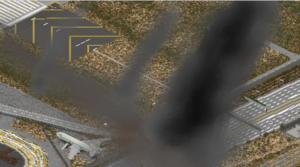Golden Pacific Flight 008
| Accident | |
|---|---|
| Date | March 14, 1996 |
| Summary | Runway overrun following pilot error due to inclement weather |
| Site | Interstate 205, Lannex, Greenfield, California, United States |
| Total fatalities | 204 |
| Aircraft | |
| Aircraft type | Boeing 777-200ER |
| Aircraft name | Boeing 777-200ER |
| Operator | Golden Pacific |
| IATA flight No. | GP008 |
| ICAO flight No. | GPA008 |
| Call sign | GOLDEN 008 |
| Registration | N27873 |
| Flight origin | Kingsford Smith Airport, Sydney, Australia |
| Destination | Greenfield International Airport, Greenfield, California, United States |
| Occupants | 192 |
| Passengers | 184 |
| Crew | 8 |
| Fatalities | 192 |
| Survivors | 0 |
| Ground casualties | |
| Ground fatalities | 12 |
| Ground injuries | 21 |
Golden Pacific Flight 008 (GP8/GPC8) was a scheduled passenger flight from Sydney Kingsford Smith Airport to Greenfield International Airport. On March 14th 1996 the Golden Pacific Boeing 777-200ER operating this flight overran the runway while landing due to a loss of control resulting from strong crosswinds. There were 192 casualties on the plane and a further 12 on the ground, making for the deadliest accident in GIA since a Lockheed Electra operated by the Marine Corps crashed into the bay in 1973, and the deadliest in all of California.
The aircraft was damaged beyond repair and was subsequently written off.
Aircraft
The aircraft involved was a Boeing 777-200ER powered by 2 General Electric GE90-95B engines, registration N27873. It rolled out of Boeing's production line in Everett on April 6, 1996, first flew the day after, and was delivered brand new to Golden Pacific on July 18, 1996.
Accident
At around 9 AM PST on 14th of march 1996. Golden Pacific flight 008 took off from Daniel Inouye Airport in Honolulu and started its 5 hour journey from Hawaii to the GIA airport. The Boeing 777-265ER had 192 souls on board. The plane started its approach to land on runway 9R, however, right before the plane would be able to touch the runway, strong crosswinds pushed the plane slightly to the left and the plane had to go around and try again. Around 4:30 pm PST the plane touched the runway again and started slowing down.
However, due to the heavy winds and a pilot error, the plane was pushed to the right and hit a taxiway sign causing it to lose a wheel tyre a few seconds after touchdown. Due to this the plane was not able to stop in time and ended up crashing through the fences and right into the busy highway I-205. The plane hit around 15 cars before the fuel exploded seconds later.
The plane crash ended up taking the life of 192 passengers on the plane and 12 people on highway I-205, and led to the hospitalization of 21 more people.
The wing separated from the fuselage and hit the ILS systems, causing a short circuit and causing a small fire. The fire also caused the electricity supply of 27R's ILS systems to be disabled.
It took around 2 weeks to clean up and fix the highway and airport. This caused mass traffic issues in the areas of Lannex and Rio Pueblo. This also caused SFO and LAX's air traffic to increase due to the reduced aircraft movements the airport can take per day. Additionally, the ILS systems were broken on approach to the runways heading west, meaning if the prevailing winds were from the west, planes had to approach visually or divert to another airport. Both systems were fixed on 2nd of april.
Investigation
Initial investigations revealed that the plane landed at least 900 meters beyond the usual touchdown point on Greenfield's 1,850 meter long runway. A team of airline officials, staff and officials from Greenfield International Airport Authority were rushed to the scene to investigate the accident and assist with rescue efforts. Boeing also announced that a team would be sent to provide technical assistance following a request from local authorities. The Bureau d'Enquêtes et d'Analyses pour la sécurité de l'aviation civile (BEA) from France ordered an inquiry into the crash, which began the same day. The US National Transportation Safety Board (NTSB) also assisted the investigation by sending a team of specialists including a senior air safety investigator, a flight operations specialist, an aircraft systems specialist and technical advisers for Boeing and the Federal Aviation Administration.
The attribution of pilot error as the root cause of the incident was voiced at a Golden Pacific conference days after the incident. Safety Manager of Golden Pacific, Viraj Sumbarhik, concluded that:
"The plane had sufficient fuel to divert to Los Angeles or San Francisco that had much longer runways. The only inconvenience is that passengers on a connecting itinerary would have less convenience due to that, but that should be relatively fine. We always prioritise safety over anything else here at Golden Pacific."
Costs incurred
This incident cost around 1 million USD to repair the airport walls and around $140,000 to fix the ILS systems.
As the Montréal convention has not been put in place until 1999, there was no strict regulation as to how much Golden Pacific owed to the families of those perished. This ensued into one of the most fierce legal battles in Greenfield courts as one of the families requested much higher compensation costs than what was offered by Golden Pacific themselves. The case had been brought up to the Supreme Court in 1998, after which the lead judge decided that Golden Pacific was to pay the family of each one deceased $230,000 USD in compensation. (This meant that if 4 people from one family perished in the accident, the airline owed the family $920,000 USD)
See also
References
BEA's Final Investigation Report on Golden Pacific Flight 008 Warning: deprecated link
